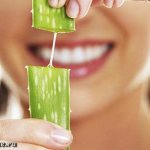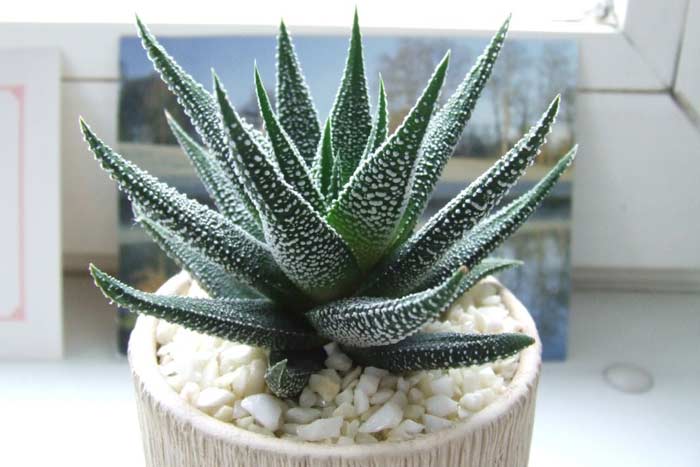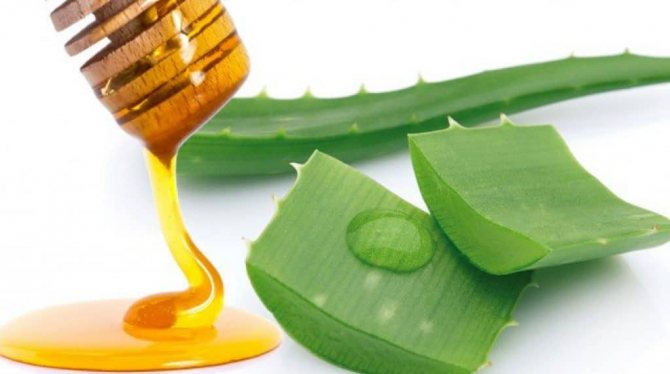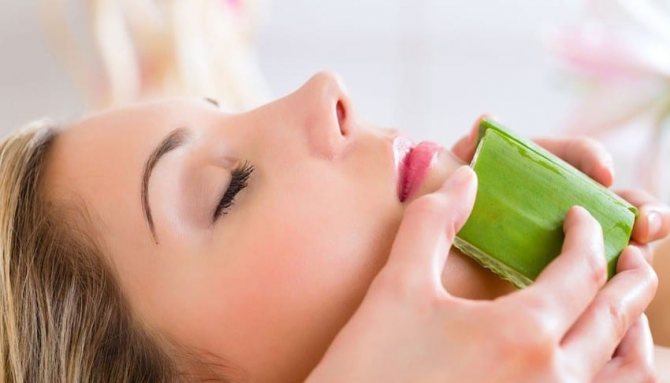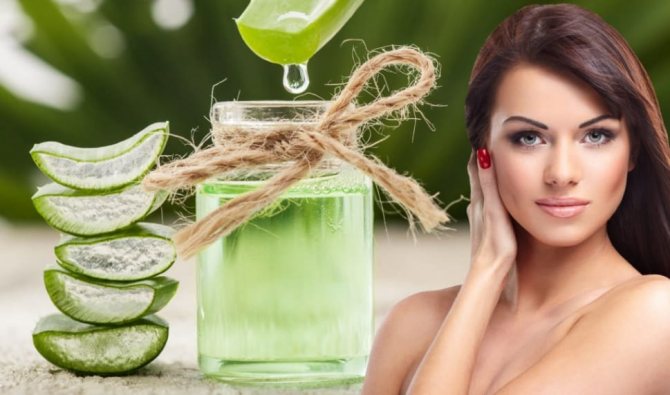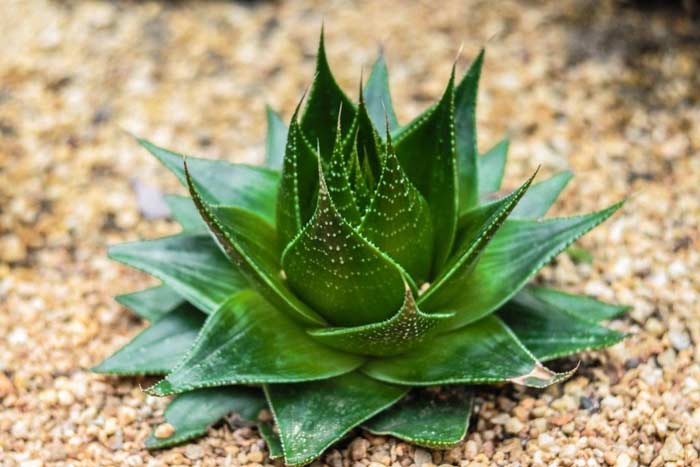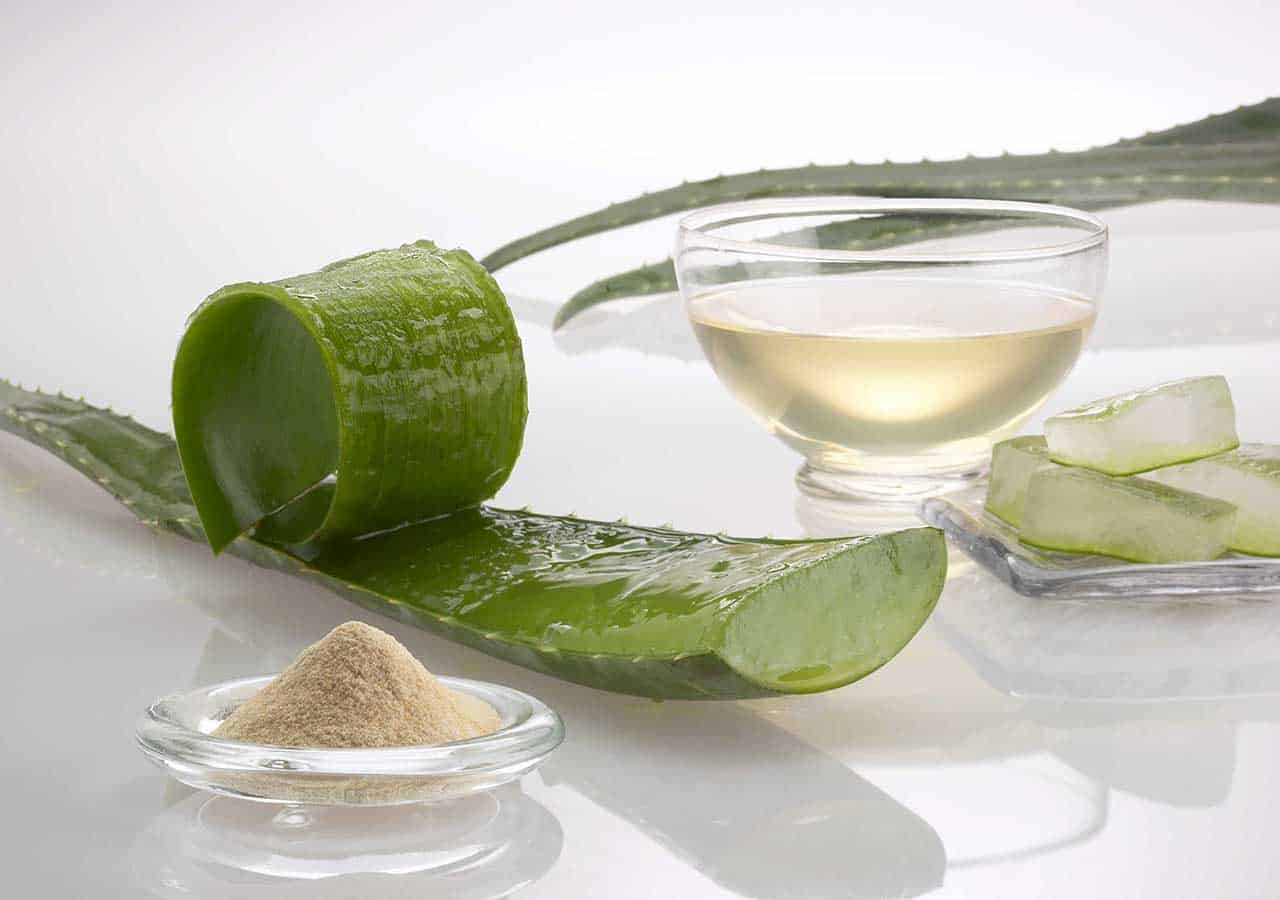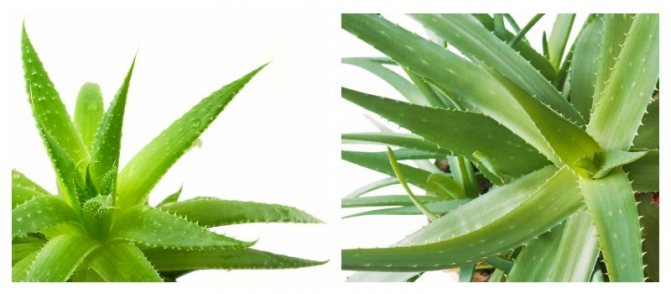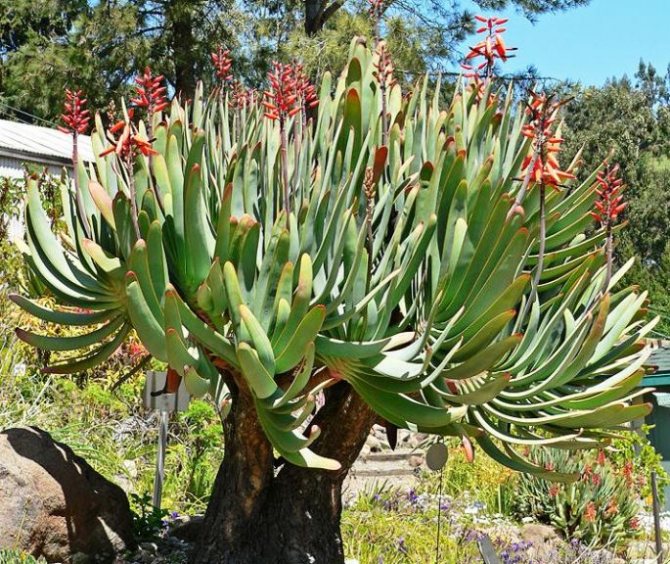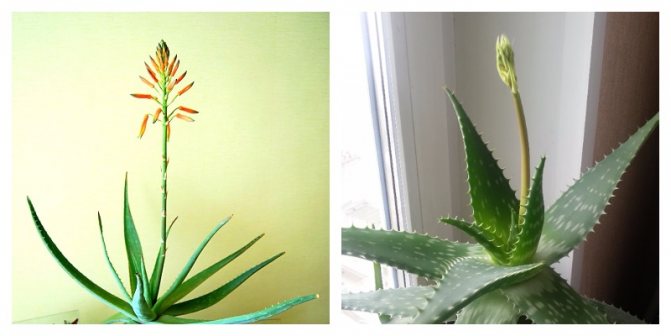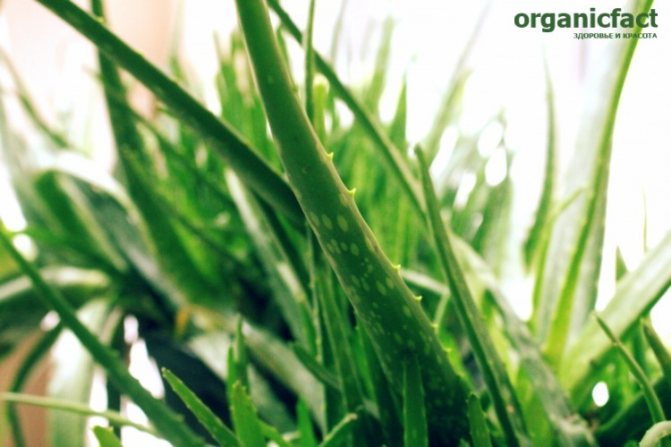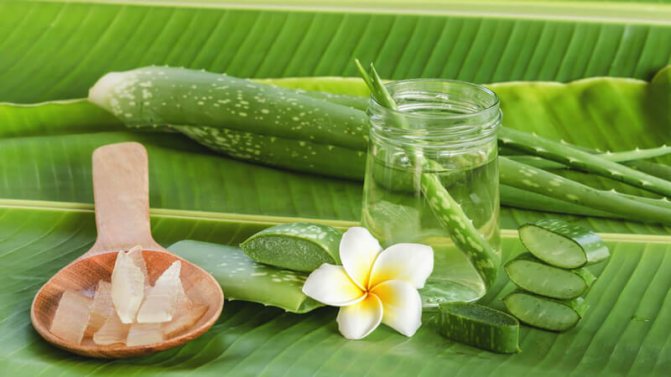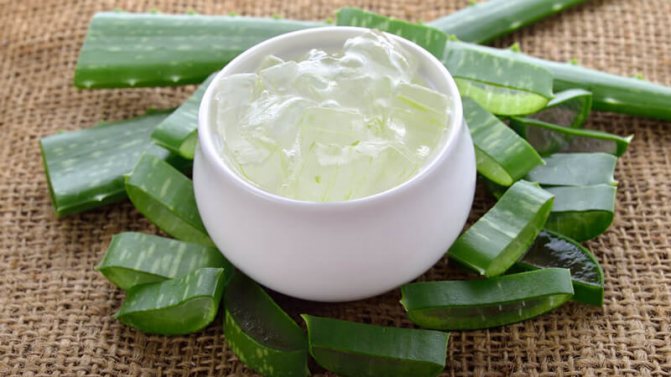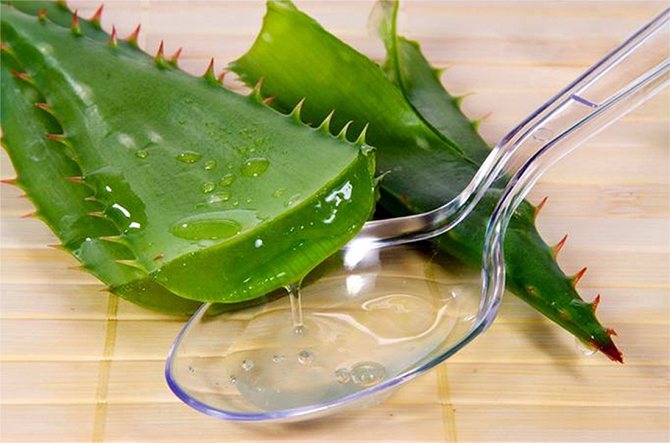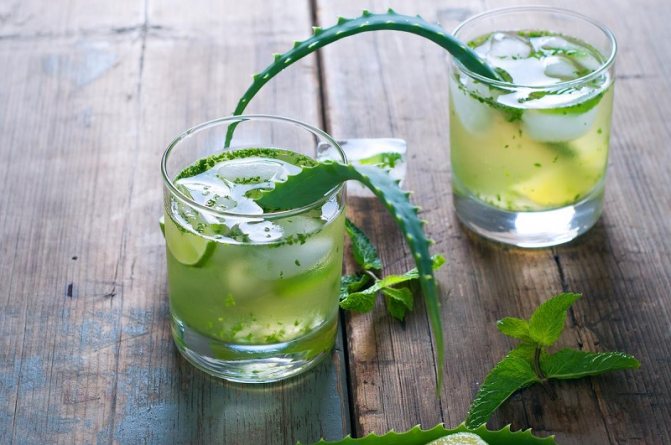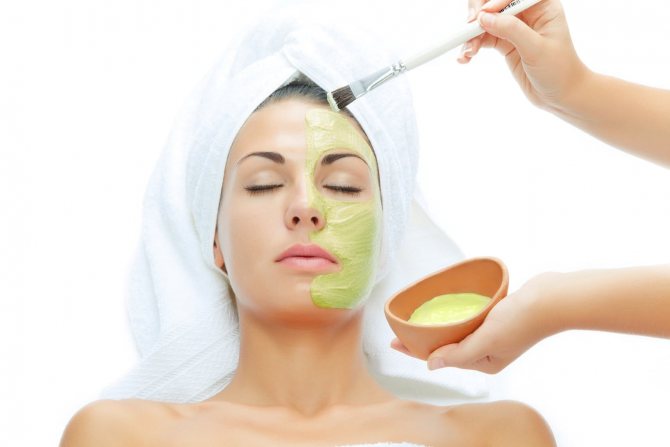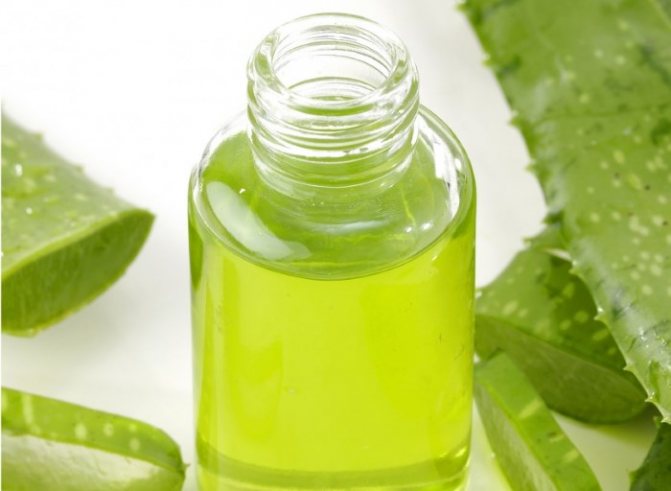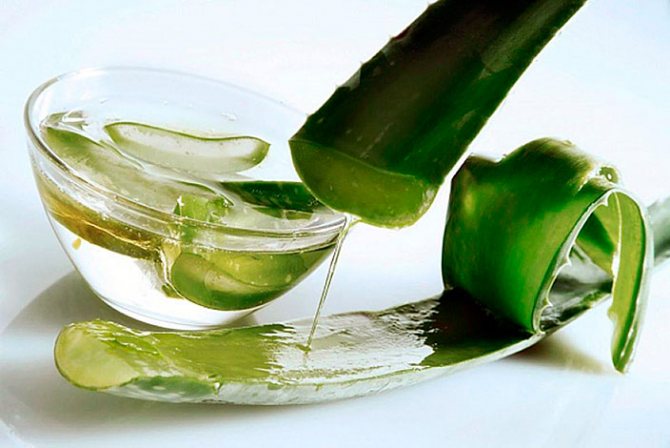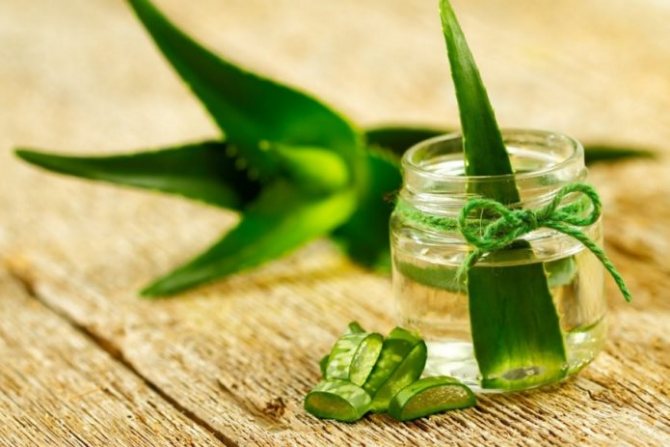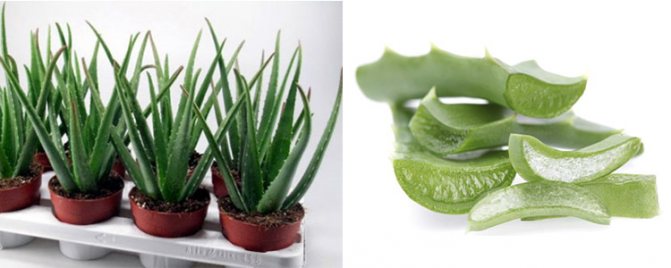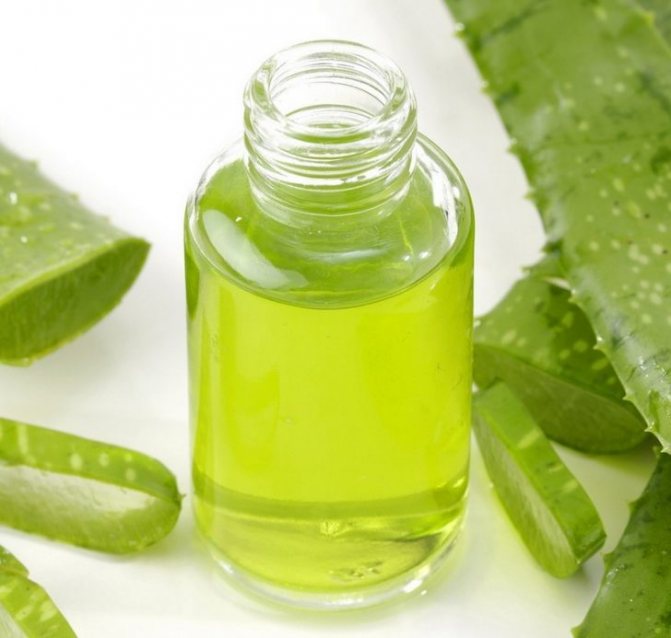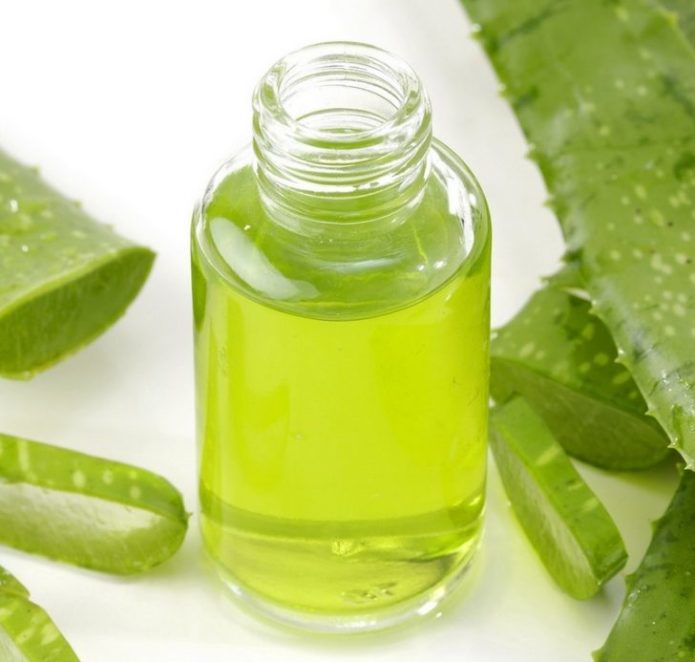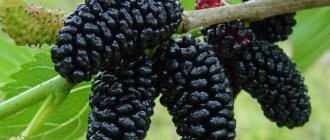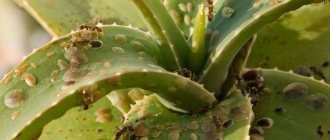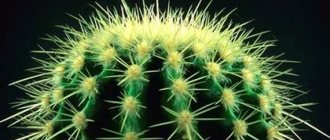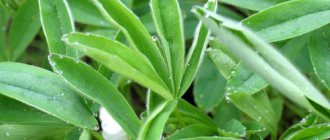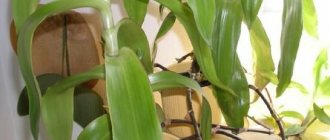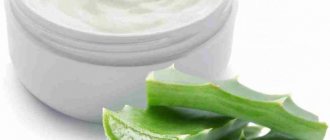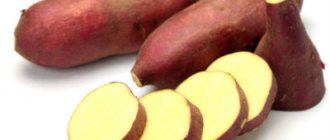Aloe is a natural healer that is found in almost every apartment. Most amateur flower growers respect this plant for its unpretentiousness and survivability in any conditions. And only a few see in aloe not just a flower, but a unique medicinal and cosmetic product. For treatment, aloe juice, herbal teas containing the flowers of this plant, as well as decoctions and infusions are used. How to drink aloe and what does it help from? How is an agave different from aloe vera? How to make simple but effective skin cleansers from aloe? Read about it in our article.
How to heal with aloe. Preparation
- Do not take a very young agave, its age must be from 2 years, otherwise it does not have time to accumulate active substances. But not older than 12 years. Keep in mind that even a very young specimen can be treated by treating wounds, bruises and bruises.
- Tear off the leaves from the bottom, you do not need to cut, they come off so well.
- It is advisable to choose leaves that are slightly dry at the ends, they have accumulated the largest amount of components useful to humans.
- Cut off the thorns at the edges.
- Peel off the peel, especially if you are using aloe for ingestion.
- To extract juice, use a meat grinder or blender, put sterile gauze in a colander and squeeze.
- If you need a small amount of juice, then it is not necessary to press through cheesecloth, just click on the cut piece of the plant and the precious juice will flow freely into the prepared dish.
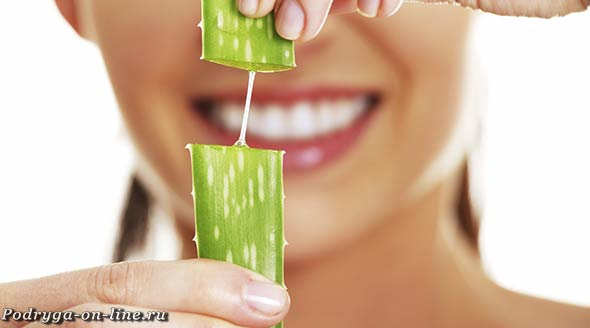
- If pulp is required, it is best to take a spoon and scrape it from the rind.
- Use the leaf after separation from the plant for 1-2 hours, because after 4 hours there will be no benefit at all from aloe. And if there is a residue, then put it in the refrigerator. It used to be the opinion that you need to hold it in the refrigerator to activate it. At first they wrote that you need to keep it in the cold 40, then 30, now they are writing 14, 12 and 7 days. But in the course of recent studies, doctors believe that just during the "activation", compounds that are dangerous for the body accumulate in the leaves. And healthy ones are preserved better in a freshly plucked leaf. But if, nevertheless, you are sure that activation through the cold is required, then put the leaves packed in bags in the refrigerator and keep them there for no more than 14 days. Indeed, after 2 weeks of such "activation" it will be completely unsuitable, especially for ingestion.
- If you have not added honey or alcoholic beverages, which are preservatives, to the juice, then it can be kept in the cold for 3 days. With preservatives, aloe juice can be stored in the refrigerator for no more than 1 year. But you can freeze aloe juice for long-term storage, just pour it into the freezer water tins that are in every refrigerator.
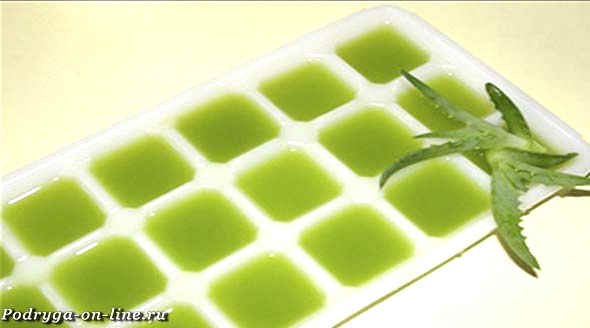

- And remember, it's best to make small portions, as the fresher medicine works better! If the recipe has large volumes, then divide them by 2 or 4.
- And be sure to take a test for an allergic reaction: smear the skin near the bend of the elbow (on the inside) with aloe juice and wait about two hours. If unpleasant sensations and red dots did not appear, then you can safely use it.
- Strictly observe the dosage, an excess of nutrients can also be harmful.
- Treatment is best done in courses, each lasting no more than 2-3 months.
- Be sure to read the contraindications at the bottom of the page.Be aware of the restrictions, as this beneficial herb can be deadly for some people.
- If you don't have Aloe growing at home, you can use ampoules from the pharmacy or ready-made nectars and ointments. But you understand that there are added preservatives and there are much fewer useful substances in such preparations.
A friend of mine, from whom I took Aloe Vera, said that she chews a leaf every day to prevent disease and therefore is completely healthy. Below are recipes for aloe from the so-called alternative medicine, which are used if the disease has already begun.
You can make these recipes from tree aloe if you don't already have aloe.
Aloe Vera Tea May Help You Lose Weight
In addition to the juice of the plant, a variety of aloe herbal teas can also be used for treatment. The flowers of the plant are used to make tea. Most often, aloe teas are used for weight loss. The essence of the effect is to accelerate metabolism, break down heavy fats and remove excess fluid.
We recommend trying aloe vera green tea. In addition to aloe flowers, it contains calendula petals, lemongrass and fruit pieces. The drink perfectly quenches thirst, strengthens the immune system, removes toxins from the body and promotes rapid weight loss.
Aloe for cosmetic purposes
Make these cosmetics from both tree agave and Aloe Vera Barbadensis Miller. It will be very good if you take it internally at the same time. You can just drink a few drops, or use any recipe you like from several components. Aloe, acting inside the body, will promote the production of collagen and other substances necessary for your appearance.
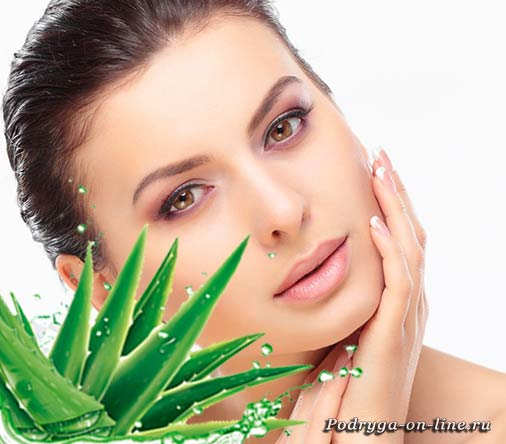

After all, folk methods do not just cure for something specific, they adapt the body to external conditions, it becomes stronger and can itself defeat any disease.
For face:
- Compress for dark circles and puffiness under the eyes
- For wrinkles around the eyes and skin refreshing
- From wrinkles and premature aging
- Stuck in the corners of the lips
Chemical composition and role for the body


Aloe vera contains more than 200 biologically active natural components, including polysaccharides, vitamins, enzymes, amino acids, anthraquinones, saponins, organic acids, phytoncides, esters, phenols, resins, minerals and other elements that promote the absorption of nutrients, improve the functioning of the digestive system , strengthen the immune system, and also cleanse the body of toxins.
It contains 20 amino acids, including those essential for humans. Aloe gel is a storehouse of antioxidant vitamins, and B vitamins. Eight enzymes that are extremely important for humans have also been found in this plant. The mineral complex in aloe is represented by calcium, copper, selenium, chromium, manganese, magnesium, potassium, sodium and zinc. The chemical composition of this succulent also includes 12 anthraquinones, which act as a laxative on the human body. And alonin and emodin endow the plant with the properties of an analgesic, as well as an antibacterial and antiviral drug. The leaves of this succulent contain fatty acids and carbohydrates, represented by both mono- and polysaccharides. Another interesting group of components of aloe is hormones. These are auxins and gibberellins, which have anti-inflammatory properties and the ability to accelerate wound healing.
And it is clear that a plant with such a unique and rich chemical composition has a huge number of useful properties. The role of this plant for human health is very great. Aloe vera is necessary, if only because the gel from it:
- improves the functioning of the digestive organs;
- moisturizes the skin;
- supports the health of the immune system;
- cleanses the body of toxins;
- improves the absorption of nutrients;
- has a high antioxidant capacity;
- maintains the natural acidity of the body;
- has a beneficial effect on the health of muscles and joints;
- prevents cardiovascular disease;
- possesses disinfectant, antifungal, antibiotic, bactericidal, antiviral properties;
- improves blood oxygenation;
- slows down the aging process;
- lowers cholesterol and blood glucose.
Aloe - homemade recipes for beauty and health
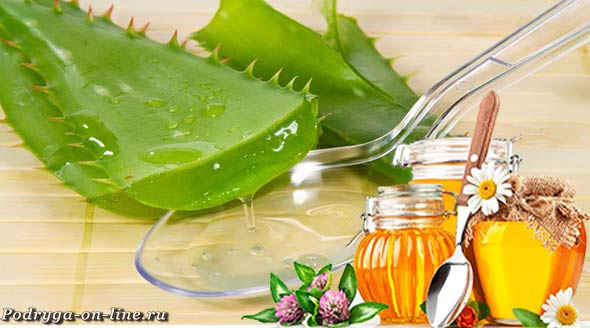

For rhinitis, sinusitis and sinusitis:
- For diseases of the nose, you need to instill aloe juice 3-4 times a day. If you are afraid of burns, it is better to dilute with boiled water in half with juice or 1 part of juice and 2 parts of water. Continue treatment until the rhinitis disappears and no longer than a week. And after instillation, the mucous membranes will begin to tingle, and you will most likely begin to actively sneeze. This will also help clear your nose faster and make breathing easier.
For a speedy recovery, take a teaspoon of aloe juice after instillation. To reduce bitterness and increase benefits, take it with honey.
- For children, it is better to make such a mixture: take 1 spoonful of juice and add 3 tablespoons of warm boiled water. And to reduce the bitterness, you can add honey to the drops.
For infants, dilute the juice with water 1: 5. Or boil 3 tablespoons of olive oil, add 1 tablespoon of aloe juice, stir and lubricate the spout 3 times a day.
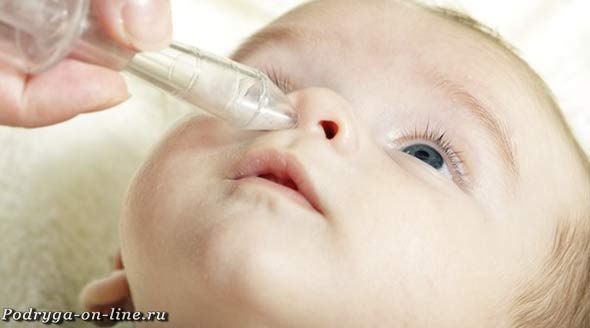

For sore throat and sore throat:
Gargle with this composition: 1 part aloe juice and 1 part warm water. The more often, the better, for example, every hour.
After the procedure, swallow half a teaspoon of aloe juice and wash it down with a glass of warm milk and honey.
If the wound is festering
First, you can prevent suppuration by immediately applying a piece of aloe leaf cut in half to a wound or splinter, or making a lotion of juice. Apply the dry side to the bandage, and apply the wet side to the sore spot, and secure with a plaster. You yourself will understand that it has bactericidal properties when it starts pinching. But besides that, it will soothe pain because it contains salicylic acid.
Pus from a small wound is drawn out in 3 nights. You can understand that the aloe has finished its work by the leaf that was tied to the wound. While the plant is working, the aloe leaf will be dry in the morning, which means you need to continue the procedure. When the treatment is over, the agave will be wet in the morning.
How to remove a splinter if it cannot be pulled out
Put on the bandage the leaflet processed as described above, while choosing the most fleshy one. And to tie to a place with a splinter, it usually helps in one night or a few hours. The splinter will simply remain on the leaf.
Care and watering, reproduction and features
Aloe is not particularly picky about leaving. It should stand in a bright place, but excessive exposure to direct sunlight is not desirable. It needs to be watered regularly - in practice, depending on the age and type of plant. Usually every few days, abundantly, but do not overdo it. A flower transplant is a rather complicated and painstaking activity, so you need to study the instructions and only then move on to the practical side. First you need to dig up a flower, then separate its roots, and plant it in different pots. The breeding process will go well when each individual flower is given proper care and attention.
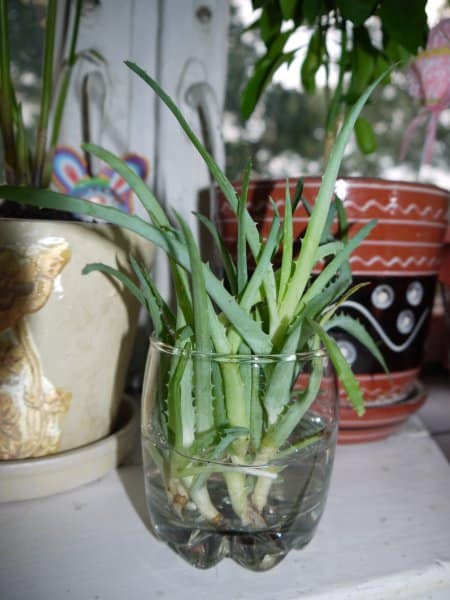

Growing a plant at home
Aloe propagates only by experienced growers who know how to transplant it. However, even an inexperienced person can transplant a plant, knowing all the rules and subtleties of the work. Since the homeland of the flower is South America, it is believed that it is difficult to get it, but nowadays you can buy it in a specialized store, but you should also take into account the harm it does to your health.
How to treat otitis media
Warm up aloe juice no higher than body temperature. And drip into the ears, 5 drops. Treat in this way for up to 7 days. It will relieve pain and disinfect.
Or moisten the pulp of the turunda plant and gently inject it into both ears. Hold for about an hour or until the pain subsides.
Or wrap aloe gel in a napkin and tie it to the sore ear for the whole night.
Cleansing the body from accumulated toxins
Take 1 kilogram of: Aloe vera leaves, butter and natural honey.
Melt the butter, add the chopped leaves, honey and mix. After the medicine has cooled down, place in the refrigerator and store it there.
Dissolve a teaspoon of the medicine in warm milk and drink it once a day on an empty stomach. Continue taking until the mixture is over. During the course of treatment, try not to eat meat, fish, flour, sweet and fatty foods.
What is Aloe Vera?
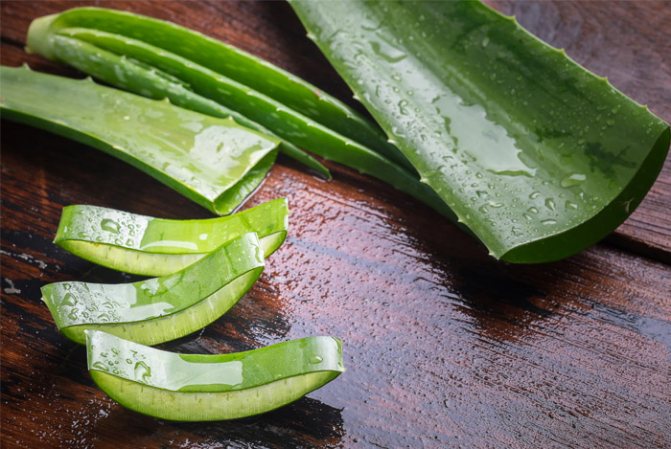

First, let's talk about what this plant is. Aloe is not a hybrid of a cactus, it is technically a succulent.
Succulents, or "fleshy" plants, often have succulent and thick leaves. This is how they differ from other plants. This is the main distinguishing feature of the agave. If you look at the aloe plant, you will notice that it is much thicker at the base. The ends of the leaves are thin and rather succulent.
Another characteristic of succulents is their ability to retain moisture in their thick leaves, which saves them during drought. It's the same with aloe vera, their fleshy leaves are filled with sap.
As for the origin, this plant was first used in China and various parts of southern Europe as early as the 17th century. You can find it in most health food stores today.
Relief from constipation
- 150 ml of aloe vera juice
- 250 gr honey
- 350 ml red strong wine
- Stir, remove in a dark place for 5 days, then store in a cold place.
- Take as needed: 1 tablespoon 30 minutes before meals.
To raise vitality and immunity.
Mix equal parts: aloe and lingonberry juices + honey. Eat 2 tbsp. spoons before each meal.
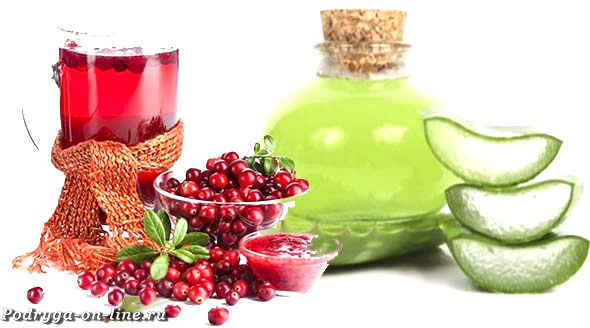

Gastritis prevention and how to cure
- If you want to prevent gastritis, then 2 times a year, within a month, drink 10 drops of aloe vera, poured into a spoonful of water. Half an hour before meals.
And to cure chronic gastritis, use this recipe
Take 200 grams each: honey and aloe pulp and 2 tablespoons of carrot juice. Stir and drink a tablespoon 30 minutes before meals.
To get rid of gastritis with high acidity, there is an old medicine that is taken in the morning on an empty stomach.
Squeeze out a glass of potato juice (use freshly prepared within the first 15 minutes). Add two tbsp. spoons of honey and 2 tbsp. tablespoons of aloe pulp (also fresh). And drink all this and eat nothing for 30-45 minutes.
For stomach ulcers
These recipes will not only help restore mucous membranes and stop inflammation, but also relieve pain, pacify heartburn and nausea.
- Alcohol tincture helps very well from this ailment, but the minus of this recipe is a long infusion period. Put half a kilo of finely chopped Aloe vera leaves, 700 grams of quality honey and half a liter of edible alcohol or quality vodka in a glass jar. And place in a dark place for 2 months. Strain, and so that the medicine does not ferment, keep the tincture in the refrigerator.
Take as a course within 6 weeks, for 30 minutes. 1 tablespoon before meals. Discontinue admission for 2 months and repeat if necessary.
- A simpler remedy. Stir in 2 tablespoons of chopped aloe and 1 tablespoon of honey. Reception for 1 teaspoon, wash down with water 30 minutes before meals - 3 times a day. Take - 3 weeks, then interrupt for 2 weeks and repeat again.
Aloe for pulmonary tuberculosis
Aloe helps fight Koch's bacillus and slows down its reproduction rate.
- This healing mixture will save you from coughing or chronic bronchitis.
- 100 grams of butter or goose fat.You can 1: 1 of both.
- 1 tbsp. l. aloe juice
- 100 g of honey
- 100 gr ground cocoa
Melt butter and / or goose fat over low heat. Add the rest of the products. Stir and take 3 times a day for 1 tbsp. spoon with a glass of warm tea or milk.
- The second recipe for pulmonary tuberculosis
- Aloe pulp - 150 grams
- Badger fat - 500 grams
- Peeled garlic 25 grams
- Birch buds - 50 gr
- Natural honey - 50 gr
- Vodka or cognac - 100 ml
- Shell from 7 large chicken eggs, finely ground
All components are mixed and placed in a jar. In a warm place, this composition is infused for 5 days, while the composition must be stirred daily.
Reception - 1 tbsp. spoon one hour before meals, up to 3 times a day.
For hypertension and to lower bad cholesterol
30 minutes before meals, pour 5 drops of freshly squeezed aloe vera juice into a spoonful of water and drink. The course is 2 months. Control your blood pressure and do not abruptly cancel the pills.
To raise vitality and immunity, as well as from chronic gastritis, stomach ulcers and dysentery
Take 10 ml of Aloe Vera juice in a spoonful of water 30 minutes before meals
From oncology and other diseases. Brazilian Priest Roman Kago's recipe
Free the leaves from edges and skin. The result should be 300 grams of pulp, which must be cut into pieces. Put them in a blender + 500 grams of honey + 4 tablespoons of quality alcohol (there was cane liqueur, but you can take any good alcoholic drink). Mix.
Eat a full tablespoon 3 times a day, 15 minutes before meals, spoon until the disease subsides.
This priest was summoned to the sick in order to receive a blessing before his death, but quite often these sick people were met with surprise on the street. It turns out that Roman Kago regaled all the dying with this potion.
At least that's what Michael Poiser said in a talk show about aloe vera. You can watch it right now, I advise, very interesting.
Indications for use
Question: what is the use of this plant will interest many who grow an agave on their window.
Centennial is known as a strong immunomodulator that helps to increase the body's resistance during epidemics. Its bioactive substances, when applied externally, enhance the processes of tissue recovery and regeneration, accelerate the healing of fresh and purulent wounds, eczema, cuts, burns, frostbite, dermatitis, trophic ulcers, allergic skin manifestations, recovery in the postoperative period and after irradiation. The antifungal properties of agave juice allow it to be used as a broad-spectrum herbal antimycotic.
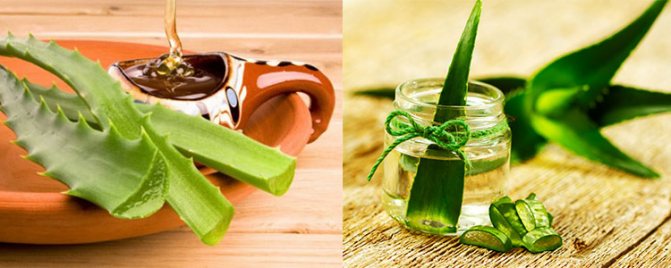

Aloe juice has an active antiseptic effect on bacteria:
- staphylococcus
- streptococcus
- dysentery bacillus
- typhoid stick
- diphtheria bacillus
The antibiotic barbaloin obtained from aloe is used in medicine for the treatment of tuberculosis, pneumonia, bronchial asthma, conjunctivitis, chronic gastritis, colitis, pancreatitis, when diagnosing progressive myopia, opacity of the vitreous body of the eye.
Due to the mild diuretic effect and pronounced disinfecting properties, drugs based on this plant are effective in the treatment of diseases of the urinary system.
The use in certain dosages of funds based on it is prescribed for chronic and atonic constipation, to stimulate the intestines.
It is used in complex therapy for the treatment of intoxication of various origins, inflammatory processes associated with the oral cavity: stomatitis, abscesses, pharyngitis, sore throat, concussion, conditions associated with impaired psycho-emotional balance, neuroses.
Its use eases the condition in diseases associated with metabolic disorders in the body: diabetes mellitus, lupus erythematosus, joint diseases. Drinking agave juice promotes better absorption of iron-containing preparations, minimizing the negative effects of antibiotics.
The most widespread medicinal properties of aloe vera are manifested in the following directions:
- Suppression of inflammatory processes, prevention of scarring on damaged tissues.
- Intensive hydration, prevention of skin loss of elasticity, firmness.
- Calming, reducing skin allergic manifestations of any etiology.
- Normalization of the functions of the digestive system when taken orally.
- Healing of damaged tissues as a result of mechanical and chemical action.
- Antifungal, antibacterial, antiviral action for external and internal use.
Aloe for face care
If your skin is sensitive or dry, then do not apply aloe juice without first diluting it with water! Otherwise, you may feel a strong burning sensation.
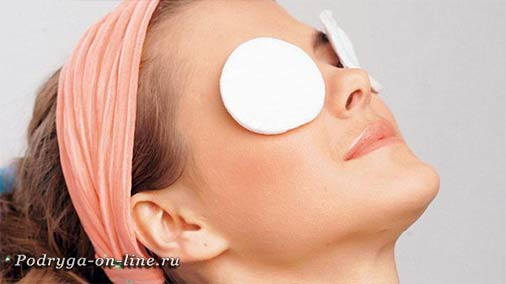

Grind the agave pulp. Wrap in a clean cloth.
Lie down and place a wrapped aloe under your eyes, wherever swelling and dark circles have formed, take a towel, as the juice can drip onto your face. Relax in this form for about half an hour or more.
After the mask, you can wash your face, smear with cream, or you can not.
From wrinkles under the eyes
- Cut a cotton pad into 2 semicircles with scissors, saturate with aloe juice and place under the eyes. Keep it on for at least 30 minutes.
And to refresh the skin around the eyes, soak a whole cotton pad with juice and put it in the freezer for 10 minutes. Put on closed eyes for about 20 minutes. After the procedure, it is better to spread it around with eye cream without rinsing off the juice. Or wash off the juice and not smear anything - whatever you want.
Aloe for wrinkles and early aging
The simplest thing is to divide the leaf, after cutting off the thorny parts, and rub your face directly with this leaf, pressing on the flesh, mostly wrinkled areas. After it dries, you can spread it with cream, after which the face will begin to tingle. It's okay - this is disinfection from various pimples and micro-inflammations.
Or mix honey and Aloe pulp in half and mask for 30-40 minutes. This mask will moisturize the skin well and smooth out wrinkles.
Treat bumps in the corners of the lips
This unpleasant phenomenon is also treated by the agave. Just squeeze the juice onto cotton pads and press on the sick as often as possible during the day, and brush with aloe juice at night.
For hair beauty
You can rub in the agave juice before each wash 30 minutes before, and enjoy your hair. Or use mixtures that enhance the effect of aloe juice.
Mask that nourishes, moisturizes and accelerates hair growth
Egg yolk + one spoonful of juice and olive oil + 4 tablespoons of kefir + vitamin E and A, one capsule each. Smear the scalp one hour before washing. And cover with a plastic cap and towel to create warmth. Then wash your hair as usual.
If hair falls out
You need to mix an ampoule of niacin (vitamin B3) and tsp. aloe juice and rub into the scalp after washing. Moreover, the composition should be applied immediately, otherwise vitamin B3 will lose its healing properties in the open air. Do this 1-2 times a week. After 30 days, you will notice that the hair on your head has become much larger and they begin to fall out less.
Aloe can rightfully be called a cure for all ailments. And now read under what conditions it is categorically impossible to use this home doctor, otherwise he may be harmful.
Biological characteristic
Biologists know about the existence of at least 400 species of aloe, but the most popular and with many beneficial properties is Aloe Barbadensis Miller, aka Aloe Vera or real aloe.But the variety that many grow as a house plant is aloe tree-like, which almost does not differ in its chemical composition from Barbadensis Miller.
Aloe is a perennial succulent plant native to East Africa (presumably from Sudan, from where it spread to other warm regions, including other parts of Africa, Asia, India, Europe, America). Aloe, as a rule, has no stem, or it is very short. In its natural environment, the plant can reach 80-100 cm in height. It grows rather quickly, releasing new shoots from the roots. Lanceolate leaves are thick, fleshy, green or gray-green in color with jagged edges. At the base, some leaves can be 7-10 cm wide and weigh up to 2 kg.
By the way, the leaves of plants of the genus Aloe consist of 4 parts: the peel (which is the outer protective layer), juice (a bitter liquid that protects the plant from animals), plant mucus and gel-like pulp (used to make various aloe-based products).
The leaves of the plant taste bitter (hence the name: "aloe" is translated as "bitter"). Speaking about the components that make up the structure of the leaves of this succulent, it is important to say the following. Many people use the terms "aloe gel" and "aloe juice" interchangeably. But it is advisable to understand the difference between these substances. The term "gel" is used only to refer to the substance obtained from the inside of the leaf, while "juice" is a yellowish milky liquid (latex) contained just under the skin of the leaf.
Some researchers categorically argue that only aloe gel has beneficial properties.
Grown at home, this plant rarely pleases with flowers, but hanging tubular flowers regularly appear on a 90-centimeter peduncle in the natural environment. Due to the fact that the homeland of Barbadensis Miller is warm African lands, and its thorny leaves to some extent resemble cacti, some people mistakenly "attribute" this plant to cacti. In fact, aloe is a member of the lily family. And a unique ability allows it to survive in an arid climate: to prevent moisture loss, the plant closes the pores on its leaves.
Contraindications to the use of Aloe:
- Various bleeding.
- For any inflammation.
- Not allowed for pregnant women, as the juice contains anthraquinones, which increase the tone in the uterus.
- If you are breastfeeding your baby, the milk may turn bitter.
- Allergy to aloe.
- Diseases of the liver, kidneys and gallbladder
- Diabetes - Aloe Vera Barbadensis Miller May Lower Blood Sugar Levels In Some People!
- Heart ailments - May decrease blood potassium levels.
- If you are taking any medicines: digoxin, glibenclamide, or diuretics.
- You cannot use aloe for more than a year without a break!
The dosage must be strictly observed, otherwise aloe can cause internal bleeding, pain in the heart, kidneys and other organs. And no matter how many good reviews about the miraculousness of any folk remedy, be sure to consult with your doctor.
With respect,
Who shouldn't drink aloe juice: benefits and harms
Unfortunately, even the most useful plant has its own contraindications. Aloe is no exception. This harmless indoor flower, with uncontrolled treatment, can cause serious harm. The most correct decision is to consult a doctor before taking the remedy. If "white coats" are definitely not yours, remember that aloe is prohibited:
- Pregnant women, women during lactation, children under 12 years old.
- Women during the menstrual cycle due to the serious risk of intrauterine circulation disorders.
- People with exacerbated gallbladder disease.
- With chronic exacerbation of hemorrhoids.
- People who are carriers of hepatitis A.
- People suffering from severe kidney disease such as cystitis, nephritis.
The healing properties of aloe
You can also read about growing aloe at home on our website, and this article will focus on the benefits of the plant.
Our ancestors knew about the healing properties of the juice and pulp of aloe leaves more than 3 thousand years ago. Ancient healers used the miraculous power of the plant in medicinal compresses and decoctions. Aloe juice with milk has been used to treat kidney infections, and it has been added to drinks to promote health. In nature, there are about five hundred species of aloe. And each of them has one or another healing properties. In indoor floriculture, mainly aloe vera and aloe vera are grown.
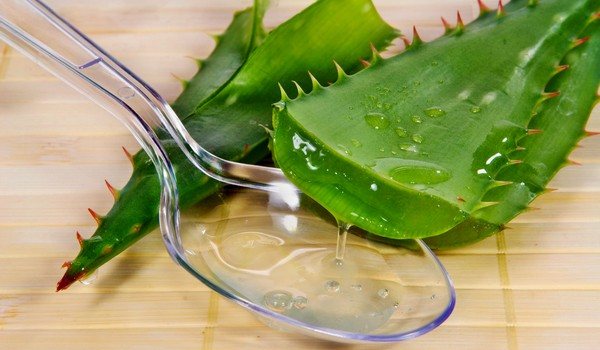

When cutting a leaf, you will see a stretching transparent jelly mass - this is a gel
Milky sap is found under the skin of the leaves and is yellow in color. Aloe juice is a valuable product. In terms of composition, it is very rich and varied. It contains essential oils, resins, trace elements, organic acids. I would especially like to highlight the presence of many vitamins there. The most important ones are: vitamin A - Beto-Carotene, vitamins B12, C, P, E. Large, fleshy, succulent leaves of the agave contain whole complexes of biologically active substances - nutrients, polysaccharides, bioflavonoids, amino acids. Moreover, of the twenty types of amino acids contained in the human body, nineteen are in the juice of this wonderful plant. I would especially like to note that there are seven amino acids in aloe that the human body does not produce itself. They must be obtained from the outside, from the food consumed.
Aloe juice also contains over 30 minerals that ensure the proper functioning of all vital systems of the human body. For example, potassium contributes to the normal functioning of the contractile function of muscle tissue; calcium and phosphorus are necessary for the formation and strengthening of bone tissue; sodium is necessary to maintain an ideal water-salt balance; iron saturates cells with oxygen and maintains the required level of hemoglobin in the blood.
Present in the composition of aloe juice and other equally important minerals - copper, manganese, zinc and others. Aloe contains enzymes that improve digestion. The sugars in the juice are necessary to regulate the activity of the human immune system. Saponins have antiviral, antifungal effects. Salicylic acid has anti-inflammatory effects. This listing can be continued for a long time.
In 100 gr. aloe juice contains only 4 kcal. In 100 gr. leaf pulp about 20 kcal.
We will introduce you to the healing properties of this indoor healer, we will tell you how you can use aloe at home for the treatment and prevention of various diseases.
The magical properties of the plant
A beautiful perennial has a number of magical properties, is able to eliminate negative energy. In the rooms where he stands, it becomes much easier to breathe, and illnesses and misfortunes disappear by themselves. Moreover, not only huge, overgrown cultures have such an effect. Even a very small escape can protect the inhabitants of the house from ailments and troubles.
To protect your home from demonic evil, it is recommended to hang a dried leaf of this plant above the front door. Thanks to this, evil forces will not be able to break the powerful biofield.
Another powerful talisman is the dried leaves, stems and roots of the plant. They are placed in a small pouch and hung around the neck.
With the help of this amulet, the following results can be achieved:
- create protection against damage and the evil eye;
- avoid all kinds of trouble;
- attract good luck;
- achieve success in all endeavors;
- achieve financial well-being;
- find love.
Reviews and results
A huge number of positive reviews about aloe vera can be found on the Internet.Those who have tried the treatment with this plant notice a positive trend after a few days of taking it. Great aloe helps in the treatment of gastritis, chronic constipation. Existing wounds or burns on the skin heal faster. There are good results in the treatment of rhinitis, throat ailments and eye problems. But many are afraid to use the medicinal plant due to the large number of side effects and contraindications. The medicinal plant has many properties. But in order to direct them in the right direction, consultation with a specialist is necessary.
Rate the material:
Ratings: 1 (5,00 out of 5)
Sololu
26.02.2019
1972
0
Found a bug? Highlight it and press Ctrl + Enter
Report a bug
Similar posts
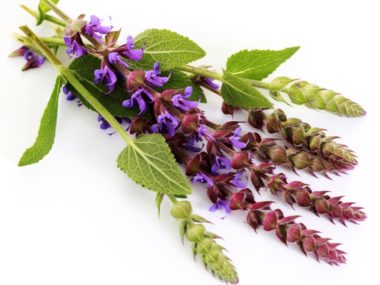

Salvia officinalis: medicinal properties and contraindications


Black elderberry: medicinal properties, application, photo
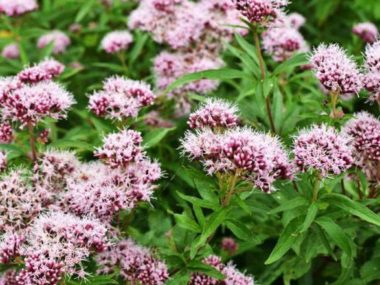

Some interesting facts
The beneficial properties of aloe vera were known to many ancient civilizations. There are records of Egyptians, ancient Greeks and Romans, early Indian and Chinese cultures. Aloe is mentioned in the Bible. The artifacts found indicate that the healing properties of the plant were known and appreciated more than 4000 thousand years ago. The earliest written mention of this succulent is a Sumerian tablet dating back to 2100 BC. e. In ancient Egypt, it was called the plant of immortality and was presented as a funeral gift to the pharaohs, Chinese and Indian healers treated them with the most serious illnesses, and in the Philippines they drank aloe with milk for kidney infections.
Aloe has been a popular medicine for a wide variety of diseases for several millennia. Today, the extract of this plant is used as medicines, dietary supplements, in cosmetics and even in the food industry. The Japanese, for example, make yoghurts with aloe extract, and in India it is often added to curries. Despite the fact that in our latitudes this plant does not occur in its natural environment, it has never been exotic for us either. Probably, for many reading these lines, a thorny agave plant has long been growing on the windowsill - that very amazing aloe that gives health and beauty.
More fresh and relevant health information on our Telegram channel. Subscribe: https://t.me/
Possible side effects
The best materials of the month
- Why you can't go on a diet on your own
- 21 tips on how not to buy a stale product
- How to keep vegetables and fruits fresh: simple tricks
- How to beat your sugar cravings: 7 unexpected foods
- Scientists say youth can be prolonged
As a rule, external use of aloe does not cause side effects, but one must be careful with the consumption of the product internally. For example, the internal use of aloe latex affects the body as a laxative, can cause abdominal cramps, as well as reduce the effectiveness of certain drugs, provoke kidney problems, blood in the urine, muscle weakness, weight loss, and heart problems.
People with diabetes should be aware that aloe can lower blood glucose levels, which can cause hypoglycemia with the use of insulin. It is believed, but not scientifically confirmed, that overuse of aloe vera gel can cause liver problems. Pregnant women are also advised to refrain from consuming the drug, as there is evidence that in some cases the plant extract can cause miscarriage or abnormal development of the fetus.
Pharmacological forms
The most effective form of aloe vera is condensed juice or sabur. In the industrial version, it looks like black-brown grains or powder. This drug is dissolved in water or alcohol.


In addition, creams and ointments, syrups and emulsions with aloe are popular. Extracts from the plant are added to immunostimulants and antidepressants.
Aloe syrup with iron
It is usually prescribed for children to treat iron deficiency anemia. It stimulates blood formation. In addition, the syrup has a tonic effect.
Aloe liniment
The drug is intended for the treatment of the skin of cancer patients after irradiation. It is applied to the affected areas, in case of severe damage, the skin is lubricated several times a day, and covered with a sterile napkin.
There is also a known preparation for injections, which is an extract of aloe with biogenic simulators.
How aloe-based preparations are prepared
For medicinal use, the largest and fleshy leaves of aloe vera are chosen. It is believed that a plant must be more than 3 years old in order to accumulate a sufficient amount of nutrients in it.
The selected leaves are cut at a distance as close to the stem as possible, after which they are washed and peeled from thorns and peels. This leaves strips of translucent pulp. To make juice, it is cut into small pieces. Squeeze it out with gauze or a juicer.
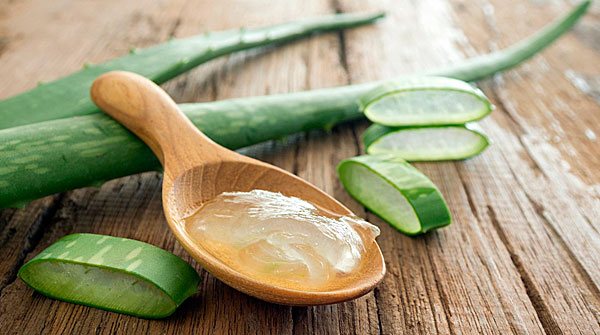

Freshly cut leaves, sliced leaf and prepared aloe juice in a spoon
Some traditional medicine recipes are based on using the pulp of aloe directly. In these cases, it is cut into smaller pieces and lightly crushed until the juice is released. Also, other components are often added to medicines, for example, honey, Cahors, essential oils and herbal infusions.
What else is aloe useful for?
The sap and pulp of the leaves make the plant a powerful natural antiseptic. Therefore, the use of a flower in the treatment of purulent wounds, burns and trophic ulcers really makes sense. It helps to suspend inflammatory processes, accelerate tissue regeneration.
Aloe-based preparations have a pronounced analgesic and immunostimulating effect - they naturally strengthen the body's defenses. Aloe also helps to lower cholesterol levels by destroying plaque in blood vessels.
A separate topic is the use of aloe in the beauty industry. Even at home, procedures can be arranged that will not be inferior to expensive sessions. Aloe juice has a beneficial effect on the skin and hair. In a word, there are a lot of reasons to settle such a useful "guest" on the windowsill.
We also recommend that you read: Everything about Aloe with honey: what it treats and how to use it in folk medicine ”Aloe (Áloë - in Latin) is a genus of succulent plants, the Asphodela family is one of the most famous indoor plants actively used in home cosmetology and herbal medicine. In this article, you will learn how to properly prepare a mixture of aloe with honey, what it treats, and how it should be used for various purposes.
basic information
Aloe Vera is a succulent from the asphodelic family. Like other representatives of the species, it has a poorly developed root system, but abundant, fleshy foliage with thorns along the edges, which is located on a strong, fleshy stem.
The leaves form a rosette, the diameter of which can reach 50–60 cm. They contain a yellowish gelatinous mass. In its natural environment, the succulent begins to bloom, ejecting a 70–90 cm vertical peduncle. Flowers form an inflorescence, more often yellow, less often, red.
It is interesting! The name of the plant "aloe vera" is translated from Latin as "true aloe." This confirms that the succulent really has unique healing properties, which is beyond doubt.
Aloe vera is not the only name for this plant, it is also called Indian or first aid flower, Lanza's aloe, barbadensis or Barbados houseplant.
Aloe Barbados succulent, most likely named because of the place where it grows. In its natural environment, it can be found on the islands of Barbados and Curacao, Morocco, Egypt, India, Sudan and China. The succulent came to European countries thanks to Alexander the Great.
Today, aloe vera is a fairly common representative of the flora, which is cultivated as an outdoor plant where climatic conditions permit. And besides, it is popular with many flower growers.
It is interesting! True or true aloe is a relative of the aloe tree, better known as the agave. They belong to the same species and are similar in appearance. True, in the representative of the first type, the foliage is wider and fleshy, it contains a gel mass. And the leaves of the agave are narrow, elongated, filled with liquid. But the beneficial properties of these succulents are almost identical.
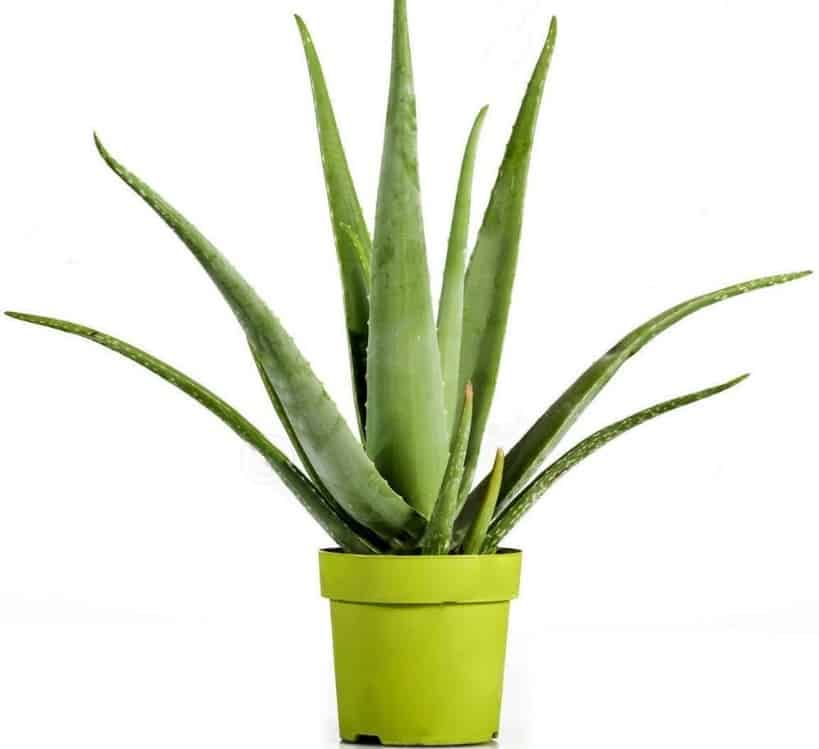

Where according to signs you can put
In fact, this perennial can be placed absolutely everywhere, but in order to fill the home with positive energy, it is worth choosing the most suitable place for the pot:
- Children's room. The plant will protect the baby, prevent the development of disease and purify the air. True, for the flowering period, the aloe must be rearranged to another place. The flowers have a strong aroma that provokes the appearance of a headache.
- Workshop. The flower will create protection, keep you from getting injured.
- Living room. In places where all family members and guests often gather, with the help of a perennial, it will be possible to create harmony, to avoid the occurrence of conflict situations. In addition, the flower will promote rapprochement, mutual understanding.
- Hallway. Thanks to aloe, it will be possible to attract good luck into the house and create protection against the penetration of negative energy.
Also, a perennial will have a positive effect if it is placed in the kitchen, bedroom or study.
Collection and procurement
In order for the plant to preserve its medicinal functions as much as possible, it must be properly harvested and stored.
The most developed plates are selected, then, with a twisting movement, they are separated from the plant along with the stalk-enclosing sheaths. Do not cut or break off the leaves, as this will lead to loss of juice.
Collected raw materials of aloe vera should be processed immediately. Fresh leaves can be stored in the refrigerator for up to 7 days. They are pre-rinsed with running water to remove dirt and dust, and dried with a paper towel. Then the plates are folded into a plastic bag with ventilation holes. Raw materials should not be placed in an airtight container, as this will lead to its deterioration.
To obtain dried leaves, they are scattered in a shaded place on a surface covered with clean paper. After wrinkling, the plates are laid out in cardboard boxes and store dried raw materials for no more than 2 years.
Before harvesting raw materials, it is recommended not to water the plant for 5-7 days. This technique allows you to increase the concentration of nutrients in the pulp of aloe vera.
Recommended dosages
Consuming aloe vera can be both beneficial and harmful. And in order to avoid unnecessary problems, it is important to adhere to the dosages recommended by scientific research.
Here are the most popular uses for aloe:
- for constipation - 100-200 mg of aloe per day;
- for psoriasis, skin infections, for wound healing - apply cream with 0.5% aloe extract three times a day;
- for gum disease, dental plaque - add a teaspoon of gel to toothpaste;
- with high cholesterol - within 2 months, twice a day, drink 300 mg of the extract;
- in case of inflammatory processes in the intestines - drink 100 ml of gel twice a day for a month;
- for burns - apply aloe gel (97.5 percent) daily until healing;
- for dandruff, dry scalp - add a teaspoon of gel to shampoo;
- to protect the skin from bacteria and infections - add a teaspoon of the gel to the skin lotion.
Seed propagation
After flowering, cotyledons appear on the aloe. After waiting for ripening, they are sown in containers filled with soil mixture. To create the soil, we take sand, turf and leafy soil (2: 1: 1).
It is not worth replanting fragile sprouts - be patient.When the young aloes are strong, prepare separate containers for them. The soil should be the same in composition, but with the addition of brick chips and charcoal.
Further care for young aloe vera consists of regular watering. The next spring, the plants are transplanted into spacious pots. The aloe vera flower is homemade, the benefits are obvious, since it not only disinfects the air, but also acts as a green first-aid kit.
Planting and lighting
The aloe vera flower should be planted in clay containers because the clay will absorb excess moisture from the ground. A high drainage layer is a prerequisite, because stagnant water can lead to rotting of the root system.
The plant is rather unstable. Several small stones around the base help to strengthen and support the plant, which grows every year. In summer, the succulent should be taken out into the open, because the ultraviolet rays necessary to grow a powerful stem and thick fleshy leaves do not pass through the glass.
The plant loves the sun, so the recommended planting site is a windowsill on the south or southeast side. If the aloe does not have enough UV light, it stretches. In winter, it is recommended to use additional lighting. As you can see from the recommendations, special care is not needed for aloe vera.
In spring and summer, during increased solar activity, the plant should be shaded, otherwise burns will appear. To do this, use tulle or gauze. Shade for about a week until "getting used to".
Use in cosmetology
The rejuvenating and moisturizing properties of aloe have been successfully used in facial skin care, besides, it can be used to get rid of acne and acne.
Smoothing out wrinkles and soothing irritated skin will help daily "driving" fresh aloe juice into the skin. Repeat for 10-14 days.
Mix 1 yolk with 1 tbsp. l. sour cream and a teaspoon of aloe juice. Spread on the skin of the neck and face, after a couple of minutes, apply a second layer and repeat this several times. After half an hour, wash off the mask. Repeat every 7 days. The skin is smoothed, its tone is increased and the complexion improves.
In two glasses of water, boil 20 g of aloe for 10 minutes and moisten the hair roots and scalp with the broth. This will help strengthen the hair follicles and stop hair loss.
Aloe feels great on the windowsill and does not cause any particular difficulties in care, only you need to be careful about watering. But there will always be at hand a proven remedy for a cold, colds or viral diseases, abrasions and cuts. And if you regularly wipe your face with an aloe leaf, after removing the skin from it, then the skin will become fresh, moisturized and taut.
Application during pregnancy and during hepatitis B
The use of any preparations containing juice or pulp of aloe for pregnant women is possible only externally. The remedy is especially effective for a cold. The juice is diluted with water in equal proportions. The medicine begins to work immediately: the inflammation of the mucous membrane disappears, and it has a detrimental effect on microbes. By adding carrot juice (1: 2), the mixture helps in the treatment of sinusitis.
For a pregnant woman, the use of aloe juice with vegetable oil is recommended for hemorrhoids. A compress from a decoction is relevant: pour 5 large leaves with 0.5 liters of water and insist in a water bath. In the cooled broth, moisten the gauze and make a compress.
Despite the many medicinal properties, pregnant and lactating mothers need to be wary of any preparations containing aloe. You can use different mixtures containing the agave, but only to care for the exterior. To relieve the inflammatory processes of the throat, gargles and lotions are suitable.
Article design: Lozinsky Oleg
Seating
Aloe vera flower tends to grow in height, grow, acquire young shoots.When the container becomes shallow for the plant, it is transplanted into a deeper pot. Young shoots are transplanted into a small container so that they get stronger and gain strength.
Adult plants are planted about once every 3-4 years, young plants - once every 2 years. Drainage is laid at the bottom of the container, then the substrate. After pulling the plant out of the old pot, you should carefully clean the root of excess soil, place it in a new pot and sprinkle it with substrate. Do not forget about small stones to strengthen the trunk.
How to get gel from a home flower?
Having such an effective remedy on your own windowsill, it is a sin not to use it, however, it is worth knowing how to get it and use it correctly so that the valuable substances of the succulent are as effective as possible:
- It is better to use a plant 3-5 years old - its gel contains a high concentration of valuable elements.
- Before cutting the leaves, it is recommended not to water the succulent for 5-7 days.
- It is recommended to take only the lower, most fleshy leaves, the length of which is at least 12 cm.
- Having cut off the parts, they should be wrapped in foil or dark paper, kept for a week in the cold - under such conditions, biostimulants will begin to be produced in the succulent.
- After that, the skin of the plant is cut off and the jelly-like contents are extracted with a spoon or knife.
- The composition should be placed in a sterile container and used as directed.
The gel should be stored in the refrigerator, but not more than 3 days. It is used both in pure form and for the preparation of medicinal and cosmetic compositions.


Where else is the plant used
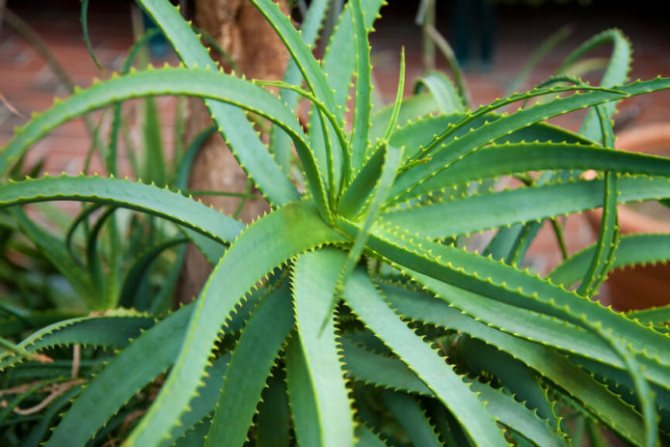

Aloe leaves are rich in the Aloe-M1 component, which has high regenerative properties and inhibits the growth of cancer cells
Aloe juice diluted with water can also be used for the following purposes:
- to bury the eyes in infectious diseases and in the nasal passages with a runny nose, sinusitis, sinusitis;
- for washing and douching for gynecological diseases and inflammatory processes;
- treat wounds, burns and other skin injuries, treat boils, psoriasis, dermatitis and eczema;
- gargle with sore throat, mouth with gingivitis, periodontal disease, toothache;
- taken orally with a decrease in immunity and frequent colds;
- rub into the scalp to eliminate baldness, dandruff and dry skin;
- use for disorders of the nervous system, insomnia, frequent stress;
- used as part of complex therapy for the treatment of disorders of the kidneys, pancreas and biliary tract, tuberculosis, benign and malignant tumors.
In small doses, aloe juice can be used to treat and prevent any disease. It is important to observe the dosage and the rules for preparing medicines from the plant, monitor the reaction of the body, and consult a doctor before use.

